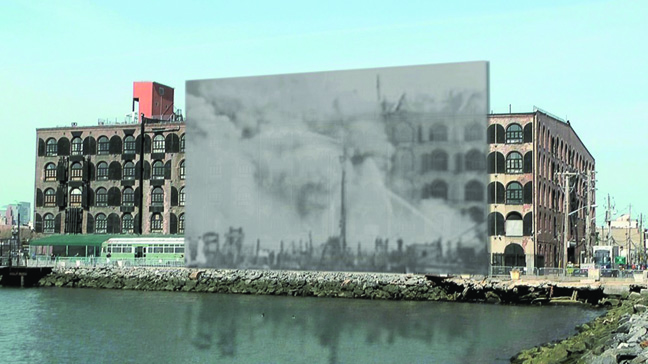The Smoke of the Flames could be noted from Lower Manhattan

“The destructive force of a fire leaves a permanent trail of information. By using the archival information from various fires that occurred over the past two centuries, the development of the neighborhood will be reconstructed.”
Join Pioneer Works on July 14 for a unique lecture on the past fires of the Red Hook village. Josh Parker will be presenting a historical background based on research he “accidentally fell into” while working on his Masters at Hunter College.
The experimental piece is based on ideas from a group in France in the 1960s called Situationalists International. “It’s about just moving through a neighborhood and letting the geography tell you about the neighborhood, which led to a deeper project while doing historical research,” Parker said.
Fire and crime
The Public Library has a collection called the Brooklyn Collection. He started going through all of their archives on Red Hook. The two themes that he found were fires and crime. “Fires gave me an insight into geographical history of the rises and falls of different buildings, what industries existed in certain buildings at certain times. It just gave me a broader history of the neighborhood.”
He researched these fires from 1851, when the Brooklyn Eagle began, through the late 1980s. The main cause of many of these fires was from distilleries right next door to cotton warehouses all in wooden structures.
Parker uses film footage, old photos, maps and atlases to show how streets, names and designs in the neighborhood change. He takes the images and overlays them over the current day images. “For me it’s about using digital media to fold history onto the present and visualize it.”
Parker talked about one of the fires he researched that impressed him the most. An old Sugar refinery caught fire. The sugar burned so hot that it was an 8 to 9 alarm fire with the inside of the building reaching close to 2,000 degrees, melting even the bricks. It was a big fire because it could be seen from lower Manhattan. He quoted some of his research saying, “the smoke of the flames could be noted from lower Manhattan.”
Fairway building stored cotton
He tells another story about another building that many Red Hookers are very familiar with. Fairway used to be a cotton factory. Twice lightening struck the building causing massive fires inside once in 1887 and again in 1902. The cotton was so densely packed into the building that the fires were left to burn after firefighters were unable to extinguish the flames.
“We often move through neighborhoods and we place our own knowledge or stories on things. Having that bit of insight helps enrich that experience, “ Parker said.
Pioneer Works is entering their second year of offering classes. Dave Sheinkopf is in charge of designing and choosing artists and classes. His work often involves the mix of science and art working together. “Art is a conversation between all different media,” he says.
The lecture is from 5-7 pm. Suggested donation is $5-10. Pioneer Works is located at 139 Pioneer Street.








